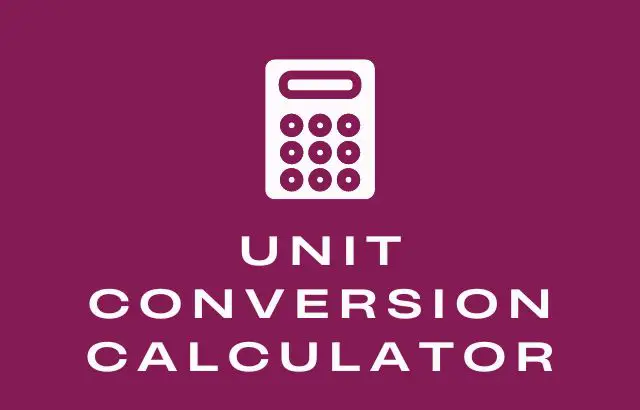Unit Conversion Calculator | Kilogram to Pound Converter
Articles, products, and services offered on this site are for informational purposes only. We are part of the Amazon Services LLC Associates Program, an affiliate advertising program. Amazon.com is compensated for sales resulting from links on our website.
Please review our disclaimer before acting based on anything you read or see.
The same attribute is expressed using a unit conversion but in a separate unit of measurement. For instance, time may be stated in minutes rather than hours, and distance can be expressed in kilometers, feet, or any other measurement unit instead of miles. This may not be easy. To help you, we have created this page on a unit conversion calculator.
Measurements are often offered in one set of units, like feet, but are required in another, like chains. A conversion factor is a mathematical equation that facilitates an equivalent exchange of feet for chains.
With the help of the Unit Conversion Calculator, you can make things easier.
What is a Unit Conversion?
Unit conversion is a multi-step procedure that includes adding, subtracting, multiplying, or dividing by a conversion factor. Additionally, rounding and choosing the appropriate number of crucial digits may be necessary throughout the procedure. To measure various characteristics, several units of conversion are utilized.
Unit Conversion Calculator
How to Convert Units?
You can convert Units through the following steps:
Step 1: Evaluate your two units.
The same object must be measured using the two units. For instance, both inches and centimeters measure the length in the issue “convert 2 inches into centimeters.” You cannot convert between your units if they measure two separate things: length and weight.
Step 2: Research the conversion.
You must first determine how much greater one unit is than the other before you can do the math. Round to the closest significant digit if the converter you discover includes several decimal places. Round to the second or third digit if you need clarification on what a significant digit is.
Step 3: Consider writing the transition as a fraction.
Include the units when writing this conversion as a fraction. Put the unit you’re translating to on top and the unit you’re starting with (the denominator) at the bottom (the numerator).
Step 4: Compose a multiplication problem
Create a multiplication problem using the fraction and the original integer. You may get the solution by multiplying these two integers together. Write down the multiplication equation first, placing units after each number.
Step 5: Rectify the multiplication challenge.
While doing this, it’s crucial to monitor your units. Each step should maintain the existence of every unit in the equation.
Step 6: Remove the top and bottom components.
Cross off any units at the fraction’s top and bottom. Your response should be whatever is left.
Step 7: Fix errors.
If your troops don’t cancel, try again from the beginning. It’s possible that you topped the portion with the incorrect half.
Types of Unit Conversions
The types of unit conversions include:

Different Systems of Units
A collection of comparable units used in computations is a system of units. Both base units, which indicate base proportions, and generating units, which reflect the products of base dimensional powers, are included in the system. Some units are found in many unit systems.
The various set of unit systems include:
- SI (International System of Units)
- 2 FPS (foot-pound-second)
- MKS (meter-kilogram-second)
- CGS (centimeter-gram-second)
- EMU (Electromagnetic unit)
- MTS (meter-tonne-second)
This has also been highlighted in the infographics below.

Frequently Asked Questions
What is the easiest way to convert metric units?
Inside the metric system, converting between units often entails changing the decimal point. You can translate inside the metric system rather quickly if you can recall what the prefixes indicate by multiplying or reducing the number by the prefix’s significance.
What are the 7 basic units of measurement?
The seven SI basic units consist of the following:
- Size in meters (m)
- Seconds of time (s)
- The molar amount of material (mole)
- Amperes of electric current (A)
- The temperature in kelvin (K)
- Luminosity measured in candela (cd)
- A kilogram of mass (kg)
How do you do metric conversions step by step?
To create a unit conversion issue where one (or more) units cancel out until just the desired unit is left, follow these steps:
- Determine which device you have.
- Choose the desired unit.
- Choose the proper unit conversion factor (s).
- Discontinue units and perform math computations (e.g., multiply, divide).
How can I fast learn conversions?
The first syllable of each word correlates to the first letter of the prefix, with U filling in for the base unit, and is a useful mnemonic for remembering the sequence of prefixes in the metric system.
The qualifiers kilo, hecto, deca, deci, centi, and milli are all explained in the song.
Expert Opinion
The multi-step procedure of unit conversion includes multiplying or dividing by a numerical ratio. Additionally, this calls for rounding and choosing the appropriate number of significant digits. NIST SP 1038 – 2006 (Section 4.4) details this multi-step method, including a rounding approach for technical publications, specifications, and other uses. Due to its diversity, the Unit Conversion Calculator will aid you immensely.



Comments are closed.